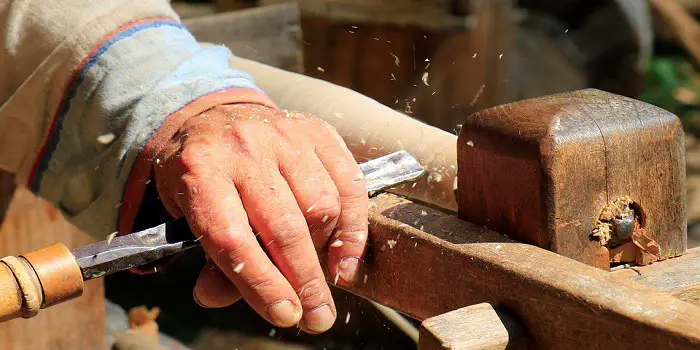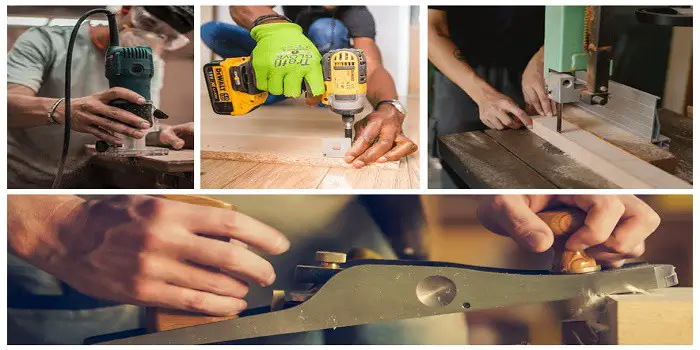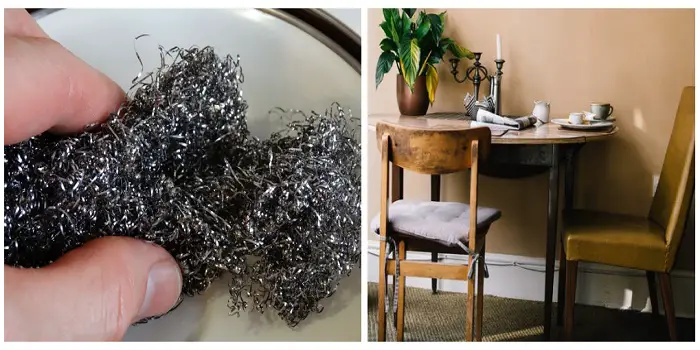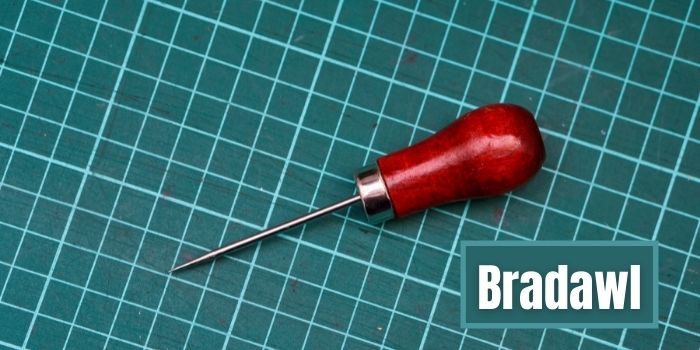
The Bradawl is a tool that often gets mistaken at first glance for a screwdriver, chisel, or even an ice pick. That’s because the general shape of the handle and the shaft make it similar to other tools.
However, the bradawl has a specific use that is quite important for anyone that works with wood.
I will be discussing all those uses here, along with some basic information on what this tool looks like, what parts it has, how it works, and how you should use it for your project.
So, let’s dive into all those details right below…
Parts of a Bradawl
The bradawl consists of four basic parts, the handle, ferrule, shank, and tip which are similar to a screwdriver.
The most noticeable difference is that a bradawl has a long handle and a relatively short shank which is normally the opposite of a screwdriver. Plus, most screwdrivers do not have a ferrule.
a) Handle:
The handle of a bradawl is usually made up of wood or plastic.
The relatively long handle is also somewhat narrow so that it fits in the palm of the hand.
The purpose is to provide a solid grip with the palm so the pilot hole can be created.
b) Ferrule:
The ferrule is a clamp of a cylindrical shape that secures the shank to the handle.
The ferrule can be pushed tightly over the wood, which prevents the handle from loosening and letting go of the shank.
c) Shank:
The shank as mentioned before is relatively short. Most shanks for bradawl tools are roughly 1 ¼” in length.
d) Tip:
The tip of the bradawl is normally shaped like a chisel, but two other common shapes include the tapered square and tapered round.
It is the tapered round shape that makes it look more like an ice pick.
The chisel tip looks like the tip of a broadhead screwdriver.
It works by the same principle as a double-beveled chisel with the point formed by cutting away from the opposite sides of the shank.
The tapered square tip, sometimes called a birdcage awl, is essentially the four sides of the square that narrow to the tip itself.
The tapered round tip is sometimes called a round-point awl. It forms its point in the same manner as the tapered square tip.
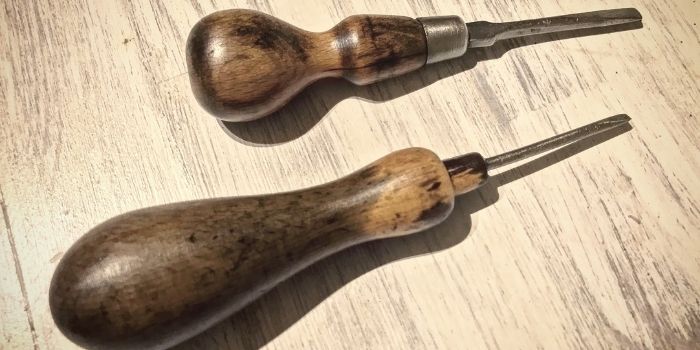
What is a Bradawl Tool Used For?
The key purpose of the bradawl is to create pilot holes for screws and nails.
This is a vital function as wood tends to either be too tough for the nail or screw to go in first.
Or the nail or screw may split the wood if a pilot hole is not created.
The bradawl makes the pilot hole so that a nail or screw can be placed before being driven in by a hammer or screwdriver, respectively.
The pilot hole the bradawl makes is narrower than the screw or nail so that either implement can stick to the sides of the wood as it is being driven.
Creating a pilot hole does take additional time, but it brings with it considerable benefits which include the following.
- Improve Accuracy of Hole Location
- Allow the Nail or Screw to be Driven in with Better Execution
- Makes the Drilling or Nailing Process Easier Compared to an Unmarked Surface.
- Prevents Splitting or Splintering
The advantage of using a bradawl is that it offers the woodworker or carpenter a tool with a wide variety of uses.
Some of the uses that a bradawl provides include the following.
1- Assembling Musical Instruments
Musical instruments that are made from wood often require nails to put together.
They are also often made from wood that may scratch or split rather easily such as the violin.
A bradawl is perfect for creating the right size of nail holes while protecting the wood. This allows for a clean finish even when putting together small pieces.
2- Door Hinges Hole Alignment
One of the biggest issues with placing hinges is the proper alignment of the holes.
The bradawl offers a simple way to properly align the holes as the hinge is being placed on the door.
3- Self-Threading Screws
While a self-threading screw has its advantages, it can also be a pain to put into wood.
A bradawl will provide the proper size pilot hole, so you can then push the screw in enough so that it grabs the sides.
This allows the screw to be properly driven into the hole at the proper point.
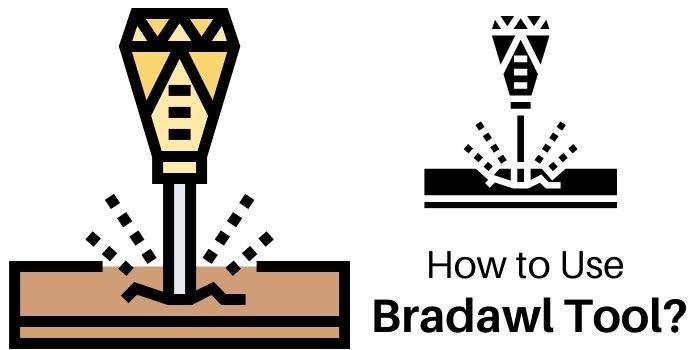
How to Create a Pilot Hole Using a Bradawl Tool?
The tool itself is fairly simple and straightforward to use.
The purpose is to create a pilot hole that provides enough depth so that the nail or screw can be placed in the desired position.
The bradawl itself is pushed into the wood at the desired location to create either a small dent or a hole, depending on what is needed.
Once you have located the exact spot where the nail or screw will be placed, you put the tip of the bradawl into that spot and use the twist and push method to create the dent.
Because the wood is being pushed, the compression effect will prevent the wood fibers from splitting or breaking open.
This compression factor continues even after you have completed the use of the bradawl.
Thus, when the larger hole is made by the nail or screw, the wood will remain strong and not split around it.
In addition to creating dents and holes, you can also mark points or make lines in the wood using the bradawl.
Such tasks are generally performed on delicate wood or when making a musical instrument.
You can also use the bradawl for the placement of jewelry.
The strong tool steel is perfect for making marks or lines in different materials when needed.
The twisting and pushing effect will create a round hole in the material.
If you need small round holes for whatever reason, especially in wood, then the bradawl is the ideal tool to use.
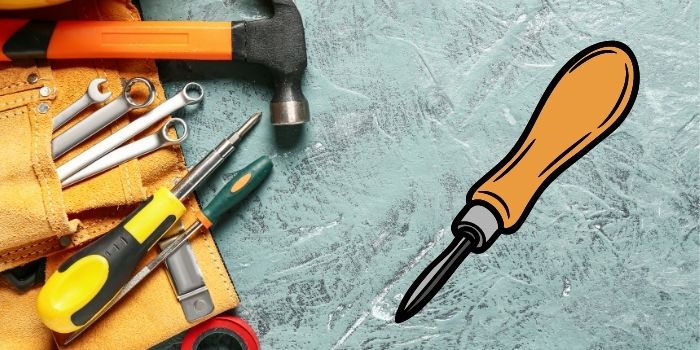
Bradawl Maintenance – Caring and Sharpening Tips
The bradawl itself is a tough, durable tool that requires relatively little maintenance.
You can clean it with a dry rag or cloth and store it with your other tools.
You can carry a bradawl in your tool belt, toolbox, or into other containers as needed.
Although tough and durable, the tip of the bradawl will require sharpening at some point, depending on its use.
Whether round, square, or chisel point, you must ensure that it is sharp enough to do the job, but not too sharp.
A bradawl that is too sharp will not penetrate the wood correctly and may cause damage.
You can use an awl, hand file, or whetstone to sharpen the tip of the bradawl.
It is suggested that you start with a standard sharpening tool and then use finer sharpening tools to finish the process.
The type of tool that you use is up to you. It is not necessary to purchase a specialty sharpening tool just for the bradawl. This is because a bradawl can be sharpened with general sharpening tools.
For example, you can use a motorized sharpening tool in which you bring the bradawl into contact with it.
Or you can clamp down the bradawl and bring the sharpening tool to the tip.
Either way, the goal is to sharpen the bradawl enough so that it can push into the wood without being too sharp.
You’ll also want to remove any dirt, debris, or rust that might accumulate on the tip.
You should also treat the wooden handle every so often with oil so that it will not dry and split apart.
Final Thoughts
An awl (also referred to as a pricker) is a pointed instrument for making holes in various materials. There are wide varieties of the awl.
A bradawl is one type of awl that is used for making small holes in wood while woodworking. An ice pick is another type of awl that is used for piercing ice.
There are also the awls that are used in industries like textiles, leatherwork, shoemaking, bookmaking, stitching, metalwork, etc.
What differentiates various types of awls is the materials they can be used on, the shape of the tip, and, the kind/size of the hole they are able to create.
So, what kind of awl or bradawl you need to get the job done depends on what type of material you are working with and the size/type of hole you need to make.

Hi, I am Mark Garner a professional carpenter, woodworker, and DIY painter. I live in the small city of Peoria, Arizona as a semi-retired woodworker. I have started this blog with a simple motive to help you with my wood experience in this sector. If you like to know more about what I love doing and how it all got started, you can check more about me here.


